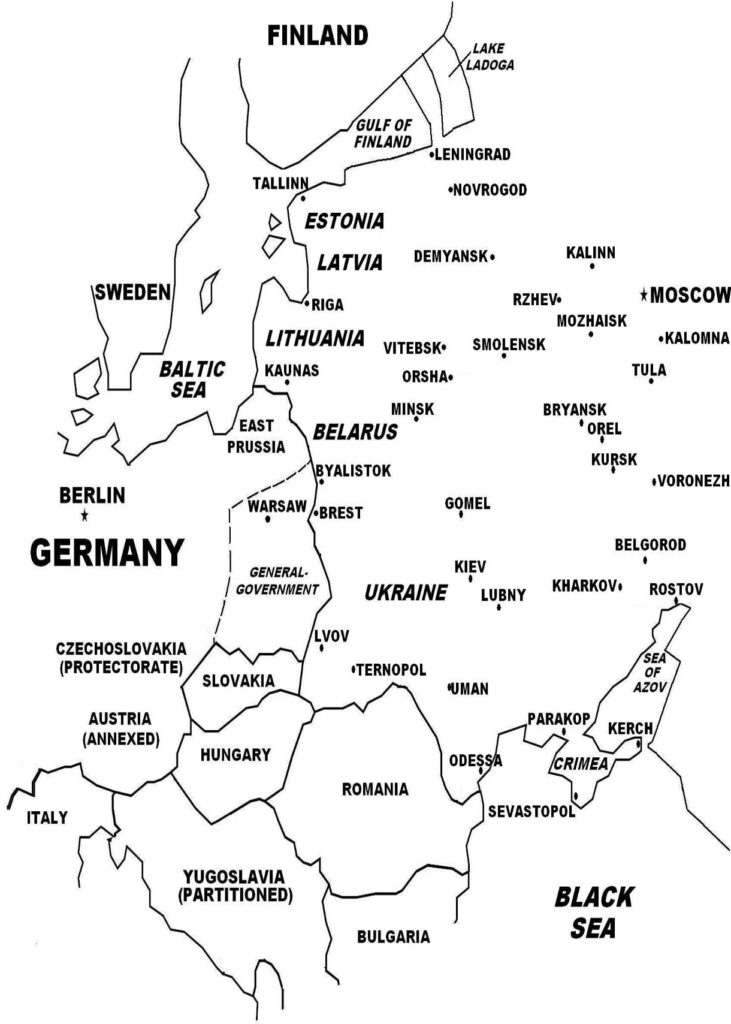In September 1943, the Soviet High Command finalized plans for a major offensive to finally eliminate the threat to Leningrad, and in the following months, massive troop buildup was made in the region under the cover of “maskirovka” (military deception) operations. On January 14, 1944, two Soviet Fronts (Volkhov and Leningrad), aided by elements of 2nd Baltic Front, the combined force comprising 1.2 million troops, 4,600 artillery pieces, 550 tanks, and 650 planes, attacked positions of German Army Group North along the Leningrad sector. German Army Group North, comprising 700,000 troops, 2,400 artillery pieces, 150 tanks, and 140 planes, was by now a shadow of its once formidable self in 1941, as its armored and other elite units had been moved to other sectors and because its frontlines were lengthened in support of German Army Group Center. The Soviets broke through the defenses, and within two weeks, had forced German Army Group North to retreat 60 miles (100 km) to the Luga River. On January 27, 1944, Stalin announced that the siege of Leningrad was over, and military celebrations were held in the city. By early February 1944, German Army Group North had withdrawn to Narva at the Estonian-Russian border, behind the Panther Line (the northern portion of the Panther-Wotan Line), which consisted of recently constructed fortifications that relied heavily on the natural defensive features of the region, including the Narva and Velikaya Rivers, Lake Peipus, and the numerous dense forests and swamps.

(Taken from Siege of Leningrad – Wars of the 20th Century – World War II in Europe)
By late August 1941, German forces had captured the last Red Army strongholds in the Baltic States in northern Estonia, forcing a Soviet naval evacuation of all Russian troops in Tallinn on August 27-31. By then also, German Army Group North’s 4th Panzer Group, now reinforced with 3rd Panzer Group, had advanced to within 30 miles of Leningrad. The Finnish Army had retaken lost territories (from the Winter War) in Eastern Karelia and the Karelian Isthmus, and was positioned 20 miles north of Leningrad. For Hitler, Leningrad not only served to protect the northern flank of Operation Barbarossa, it was also the main base of the Soviet Baltic Fleet and a major center for industries and weapons production. Leningrad’s capture also would be devastating to Soviet morale, as it was Russia’s former capital and the birthplace of the Bolshevik Revolution.
Ahead of the German advance, large numbers of Soviet troops were transferred to Leningrad. On orders of the city’s administration, hundreds of thousands of residents built defensive fortifications around the city, while 160,000 civilians joined the Red Army ranks. On September 8, 1941, the Germans cut the last land route to Leningrad, and soon also the city’s railway line to Moscow and Murmansk, thus isolating the city. On September 9, German Army Group North launched its final attack on Leningrad, which initially made good progress but by September 19, met increasingly fierce resistance and mounting casualties in the last six miles to the city. On September 22, on orders of a by-now impatient Hitler, the Germans stopped their advance and began a siege of the city, supported by air and artillery bombardment, to starve the population and inflict maximum destruction of infrastructures. This change of strategy from storming the city to conducting a siege was brought about by Hitler’s refusal to take on the responsibility of feeding the city’s large population. The siege was expected to last a few weeks, at most until January 1942, when German forces would enter Leningrad, deport the survivors to Siberia, and raze the city to the ground.
Some 1.7 million civilians were evacuated from Leningrad ahead of the German advance and during the siege, which soon reduced the pre-war population of 3.3 million by nearly 50%. The remaining population endured extreme hardships and a high death toll, with extremely limited food supplies, and disrupted water, heat, and other basic services. At its peak in early 1942, some 100,000 people perished each month, mostly from starvation.
In November 1941, Soviet forces in Leningrad opened an outlet through Lake Ladoga to unoccupied Soviet territory in the east, known as the “Road of Life”, through which the entry of food supplies and evacuation of civilians were made. This route was a waterway for vessels during the warmer months and a highway for land vehicles during the colder seasons (when the lake surface froze to ice), but was extremely hazardous because of constant German air attacks, thus its other moniker, the “Road of Death”.
For the rest of World War II, the Germans did not launch any major offensives to capture Leningrad, as Hitler became focused on other sectors, and Army Group North’s ongoing siege becoming a lower priority. The siege was one of the longest and bloodiest in history .
